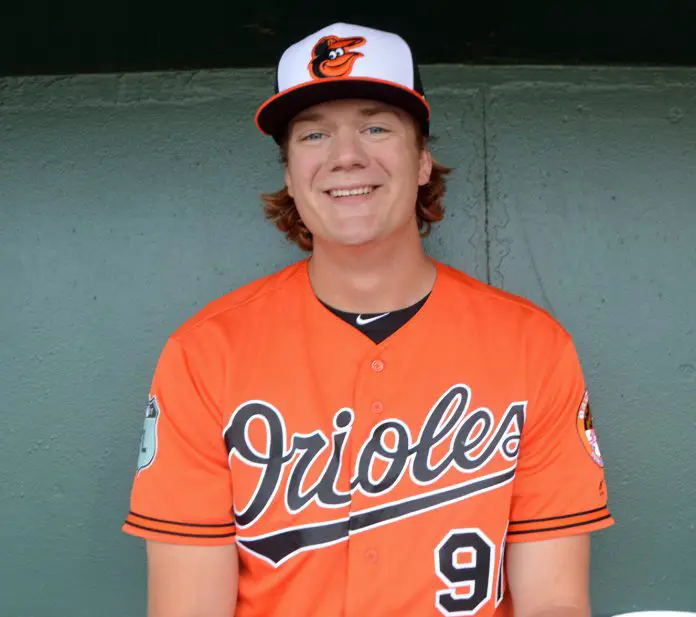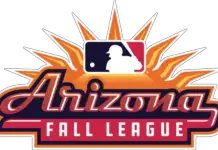Welcome to the third installment of my countdown of the Orioles Top 50 Prospects for 2018. If you want to check out the stats for these players, click their name and it’ll take you to their Baseball Reference page.
Catch up with links to the previous installments below.
#21-30
Rank – Name – Position – Highest Level – Age on opening day 2018
Tier 5 – Future Value 40
#30 – Gray Fenter – RHP – Rookie (couple of short season innings) – 22
The Orioles signed Fenter out of HS back in 2015 for 1 million, a huge overslot bonus for a 7th round pick. He only pitched about 20 innings for the Orioles GCL squad before having TJS the spring of 2016. He made his return in 2017, pitching about 30 innings, mostly in the GCL.
His stuff is reportedly back with his fastball touching 95 and a plus curveball with 12-6 shape. He creates good plane despite his 6′ frame due to a high arm slot. Fenter has a high leg kick and turns his back to hitters which complicates the delivery and probably contributes to his below average command. His changeup needs plenty work. Long way to go and he’ll need to improve command and his changeup to stick as a starter, but the chance for two plus pitches puts him here.
#29 – Jake Ring – CF/RF – Low A (couple of games at A+) – 23
31st round pick in 2016, Ring is a wiry 5’11” powerhouse. He’s surprisingly tooled up for a late round pick. Played mostly RF in 2017, but don’t let that fool you. He was just there because Ryan McKenna has more prospect status. Ring is one of the better OF defenders in all of the minors. He’s a near plus runner, has a plus arm, and has all the intangibles you want in an OF including good routes, good body control, and good instincts. I need to see him in CF more, but he’s better than plus in RF.
At the plate he has a slightly stiff, unorthodox swing. He has above average power and the strength to generate backspin. He’s hit no-doubters to CF. If he had a better hit tool, he’d be in the top 10, but it’s well below average. The bat speed is just average and he has a long swing because he extends his arms early regardless of pitch location. Ring is a poor pitch tracker and he also has trouble with offspeed stuff and gets caught out on his front foot frequently. If he hits his weight, he’s a 4th OF and there is some upside.
#28 – Nick Vespi – LHP – Short Season – 22
One of my favorites. Vespi is a big bodied lefty with a funky, deceptive delivery. He had trouble repeating it when he was drafted out of JUCO in 2015, but that’s improving.
Vespi offers a 4 pitch mix. A solid 91-93 fastball with life up in the zone and a near plus slider with multi-plane break that works against LHB and RHB. He has some feel for a changeup that lacks movement but tunnels well with his fastball and induces whiffs. It could be an average pitch soon. His curveball is well below average, it’s a big, slow looper that hitters pick up well out of hand (different release point) and contributed to 100% of the home runs I saw him give up and at least 40% of his HRs allowed in 2017. It needs to improve substantially or get dropped.
Control is still fringy even with the improvements to the delivery, and there is plenty of relief risk here. If he ends up in the bullpen, his FB/SL combo could really play up. Tempted to put him higher, but he lacks pedigree, so I need to see more in 2018. Same age as Lowther, Baumann, and Bishop but missed more bats than any of them this year.
#27 – Matthias Dietz – RHP – Low A – 22
Dietz is a big (6′ 5″) righty the Orioles snagged out of JUCO early in the 2016 draft. He was very raw at the time. He’s made some strides, but still has a long way to go developmentally. The results aren’t there yet, but more patience is needed, because there is potential. His control has improved, his delivery is still more robotic than you’d like to see, but he does have an easy arm action and a balanced repeatable landing.
Fastball sits mid 90s with good boring action. Hard for hitters to barrel up, even when he misses his spots. Still has some room to fill out his frame, so I think there may be more velocity. He has a slider and a changeup that both flash above average at times, but he lacks the command of them to get many chases. The change is particularly interesting to me since it has improved substantially since he was drafted and now offers excellent tumble. It could be an out pitch with some refinement. I think he still has a shot to develop into a 4/5th starter, innings eater type and should get another year in the rotation. If the secondaries or the command don’t improve enough, the fastball will likely be near 100 as a reliever.
#26 – Gabriel Ynoa – RHP – MLB – 24
So, my bad, Ynoa isn’t actually a prospect (50+ MLB innings). Oh well, too late to change it. Plus, I think he’s a guy who’ll be in competition for a spot on the 2018 Orioles, so a short write-up may be of some interest.
First to those who say he struggled in AAA, look past the ERA, he was solid, especially in the 2nd half. The Tides had an outfield that at times consisted of 2 DHs (Pedro Alvarez and Adam Brett Walker) and Logan Schafer (who is at least 3 years removed from being a good defensive OF). Needless to say, the defense behind him didn’t help his ERA. His fastball sits 93-95 and can touch 97. It has good late armside run, but hitters pick it up pretty well out of hand, so it’s more a weak contact than a swing and miss pitch. Average slider the gets whiffs when spotted well, fringe changeup that he doesn’t command well. He has a starter’s delivery and hold his stuff well, could be a 5th starter but doesn’t have much margin for error. He needs his best command for his stuff to play multiple times through a line-up. Probably a better fit as a reliever unless feel for the changeup improves.
#25 – Ademar Rifaela – RF – A+ – 23
Rifaela jumped onto the radar with a strong season that earned him the Carolina League MVP. He is a 5′ 10″ stocky outfielder who possesses more speed and athleticism than you’d assume looking at him. Needs to stay in shape, has the potential for a bad body. He’s got an average arm and he’s an average runner, but it plays up on the bases due to hustle. He regularly beats out IF hits and turns singles into doubles. He’s an average fielder in either of the OF corners, he’s polished out there, but is limited by lack of tools.
At the plate, the power is real, but it’s primarily of the pull variety. His outcome depends completely on his hit tool which is currently well below average, but if everything goes right could improve enough to profile as a corner outfielder. Rifaela does have above average bat speed. He’s athletic in the box and has a knack for manipulating his swing to make contact. There are plenty of problems though, he’s mostly a guess hitter due to poor zone judgement and poor recognition of spin. He also has noisy hands pre-swing which add length and a complicated timing mechanism that involves a toe tap and then a leg kick. At least some of those issues need to get hammered out or he’s going to be a AAA mistake hitter at best.
#24 – Ryan McKenna – CF – Low A – 21
Taken in the 4th round out of HS in the 2015 draft, McKenna is a small but muscular CF. His body type is similar to Jake Ring. He has above average bat speed and produces some over the fence power, it’s below average now, but could creep near average at maturity. He has a chance to stick in CF, but he’s still raw and needs to refine his route running especially on balls over his head. When I saw him, he showed a LF arm. I’ve heard reports of an above average arm though, so I’m not going to knock him off CF for that. He has plus or better speed and the instincts to steal bases at a high success rate.
McKenna struggled at the plate to begin the season. While he showed a patient approach, he struggled against good breaking balls and top velocity. Mid-way through the year, he changed his swing, lowering his hands pre-swing instead of loading them up and back. This shortened his swing and let his above average bat speed show. He proceeded to hit the ball with more authority and strike out less. If this improvement sticks, he could jump significantly in 2018.
#23 – Jhon Peluffo – RHP – Low A – 20
Peluffo had his innings limited in 2017 by piggybacking starts most of the year. He still ended up with 90+ inning pitched, a big jump from 2016. The only reason he isn’t ranked higher is his lack of pedigree and amount of development left. While he has put on some weight since his 6′ 3″ 140lb listing, he still has room for more. He’s all arms and legs. Peluffo has a methodical delivery when using his full windup, with a rotation away from the batter and a long arm action. He uses his lower half well (even though he could stand to add some strength there) and gets good extension. His balance and body control are good considering his proportions and should improve with age.
Currently, he throws strikes, but has command issues. An inconsistent landing causes wildness within the strike zone and some wasted pitches. I’m not too worried about that though, he’s athletic and when he fully grows into his body, I project average command. He has a sinking fastball with late tail that hits 95-96 at times but sits a bit lower. It flattens out when he tries to throw it glove-side. The fastball is ahead of his secondaries, but both his curve and changeup flash with potential. The slider lacks bite and all his secondaries are inconsistent and tend to be too firm at times. Has plenty of development needed, but he’s young. He’ll likely be in the Frederick rotation at 20 years old and I think he’s a breakout candidate.
#22 – Lamar Sparks – CF – Rookie – 19
The Orioles selected Sparks in the 5th round in 2017. He was more advanced at the plate than expected. He has a patient approach and a mechanically clean swing with some loft. There is no power currently, but that should come as he gets stronger and learns to use his lower half more. He has all the tools to be an above average CF, including an above average arm and plus speed. His frame is very projectable and he should develop a prototypical big league body (Adam Jones-like at maturity).
#21 – Nestor Cortes – LHP – AAA- 23
The Orioles first Rule 5 draft pick this year, Cortes should get a chance to compete for a rotation spot in spring training. I like his chances. He’s performed extremely well in the minors, while being young for his level. It’s hard to predict how he will fare in the majors due to his unusual repertoire of stuff and pitching style.
Click here for my report on him from before the Rule 5 Draft.
See #11-20 here.
Discuss here

























